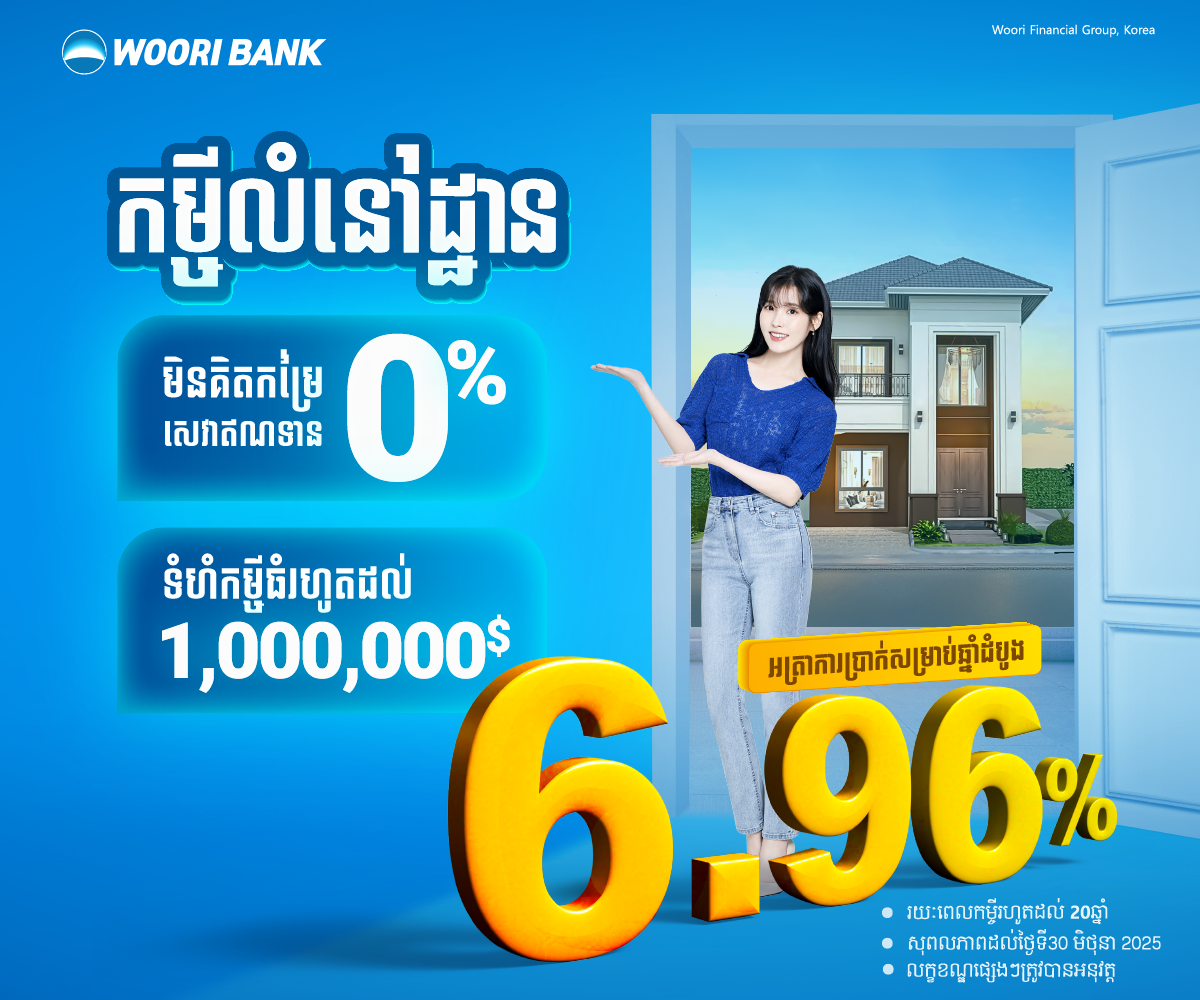
Psar Thmei, the market in the heart of Phnom Penh
WHETHER you are in the market for precious stones or chicken feet, fine silks or
tourist T-shirts, all these can be found under the imposing yellow dome of Phnom
Penh's Psar Thmei.
Psar Thmei - "New Market", but generally known in English as "Central
Market" - was built in 1937 by the French colonial government. It is one of
Southeast Asia's most distinctive markets.
Until the end of Lon Nol regime in 1975 vendors traded freely, but when Phnom Penh
fell to the Khmer Rouge the market was closed and used as a stable for horses.
In 1979 the market was reopened after the Khmer Rouge were beaten back to the jungles.
For the next 10 years Psar Thmei was run by the Government as a center for traders
doing business between Phnom Penh and Ho Chi Minh City.
It wasn't till April 1989 that the market was again privatized. Today it is a hive
of commercial activity, as well as being one of Phnom Penh's chief tourist attractions
Prak Kadol, Deputy Head of the market, said Psar Thmei is very traditional compared
to other markets in Phnom Penh.
"The tourists who come to see Angkor Wat also want to see Psar Thmei and buy
souvenirs," he said.
Phnom Penh Governor Chea Sophara said that in 1998 the municipality launched a beautification
and renovation campaign on the streets around the market, erecting lantern poles
and designating car parks in an attempt to stem traffic congestion.
There is no shortage of places to eat in Psar Thmei, like these food stalls, above and right
In 1999 the Phnom Penh Municipality and Unesco drafted an agreement to make Psar
Thmei a National Heritage site.
Sophara said the city is planning to repaint the market roof and the renovation work
is expected to finish by Cambodian New Year holidays next April.
Psar Thmei's management officials say they are uncertain about the origins of the
market's unique design, but there are numerous interpretations of what it represents.
One worker at Psar Thmei remembered his French teacher, in 1959, having a discussion
with his students about the market.
"He asked 'If you stand in the middle of the market and look up at the roof,
what do you guys see?' But none of the students showed any interest in talking about
this.
"But I suddenly remembered the teacher's question during the market's opening
ceremony on the 4th of April 1989. So I stood beneath the dome, looked up, and saw
the ceiling resembled a spider's web.
"To me it symbolized the web of French colonialism that once covered Cambodia,"
he said.
A Psar Thmei official said markets in Kampong Cham and Battambang were also built
in 1937. He thought the one in Kampong Cham looks like the fuselage of a plane, and
the one in Battambang resembles a fighter aircraft's tail. He believed these were
meant to be symbolic of France's technical superiority over the colonies, but he
said others discount this theory.
A gold seller in the cathedral-like interior
Sok Kim Heng, Head of the Market Committee, said Psar Thmei now has a total of 2,849
stalls selling 52 categories of goods which radiate out from the clock tower beneath
the center of the dome.
As tourists wander the labyrinth of stalls - dodging customers and children racing
about with trays of tea - they will trigger cries of "Buy something" from
the vendors.
If a shopper's eye lingers on an item for more than a fraction of a second, a seller
will leap into action, plucking the item from the display case in an instant. "You
want to buy?"
The stalls are organized throughout the market so each area sells only one type of
goods - for example clothes, gold, or electronics.
Heng said different ethnic groups tend to have their own niche businesses.
Khmers operate silk, samput, krama, and kaben shops and Chinese-Khmers specialize
in the gold and jewelry trade. Chams - Cambodia's Muslim community - sell most of
the fish, beef, and chickens at the market while Vietnamese prefer to run food and
drink stalls.
Vendors told the Post that the UNTAC period was a prosperous time for Psar Thmei,
but business has since cooled and they are worried that the flooding will translate
into less sales in the future.
But the vendors at Psar Thmei do not simply rely on entrepreneurial skills and their
ability to drive a hard bargain - many depend on the market's guardian spirit for
the success of their businesses.
Sreng Lim Huong, a 35-year-old gemstone vendor at the market, said she believes that
there is guardian spirit looking after Psar Thmei. She said the spirit named Lok
Ta Psar Thmei really exists and is frightening. "Whatever we pray to receive
from him comes true," she said.
Huong said one day she wanted to test the power of Lok Ta. That morning she burned
five sticks of incense in the center of the market and offered fruits and cakes to
the spirit.
Fruit and vegetable sellers and meat and fish sellers abound in Psar Thmei
"I then bowed my head three times and prayed that Lok Ta would appear before
me.
"I really saw Lok Ta in my dream that night. He was wearing only a white Kaben
[traditional Cambodian pants] with his torso bare. He had white long hair, a back
curved like a turtle and he carried a stick. He walked slowly towards me, but did
not utter a word," said Huong.
Three months ago Huong had a quarrel with a platinum vendor who had bought a $19
gemstone from her on credit. A few days later she asked the man for her money but
he refused, saying that he had already paid the debt.
"To show his honesty, the man burned nine sticks of incense and said if he was
not being truthful then Lok Ta should banish him from the market.
"Well, his oath came true," said Huong. "Three months later, the man's
business went bankrupt."
An official at the market said that before the Khmer Rouge regime, during Chinese
new year, the Cambodian-Chinese Association performed lion dances around the market
to pay respect to the spiritual power watching over it. "They performed the
lion dance (Mong Sai) to urge Lok Ta Psar Thmei to help their business," he
said.
"Now, every Buddhist holy day, about two or three times a month, I hold a ceremony
- burn incense and give offerings to Lok Ta while praying for good business,"
he said.
He has lots of faith in the power of Lok Ta because he witnessed the spirit possessing
his wife.
"One day in 1993, at about noon, I arrived home. My wife felt sick and she asked
me to rub her body with a coin [a traditional Cambodian treatment for ailments].
After I made only a few rubs, she suddenly sat up in a meditation position and starred
at me and said: 'I am Lok Ta Psar Thmei. I protect the market.' The hair on my head
raised up because I was very frightened," he said.
The official said that nearly 100 per cent of the vendors now pay respect to the
guardian spirit Lok Ta.
According to many workers at Psar Thmei, ghosts wander the building at night.
Phum Sophan, 38, a security guard at Psar Thmei, said he definitely believed the
market was haunted. He said nine years ago a ghost scolded one of his colleagues,
named Kol.
"Kol told me that one evening, just after midnight, he saw a black sha-dow coming
to him while he was lying on his bed at his post by the east entrance. The ghost
asked Kol why he blocked its way and then it pulled Kol's bed aside." Sophan
said Kol left his job shortly after.
Other vendors told the Post of special owls they believed brought luck to Psar Thmei.
Huor Sarin, 53, a vendor selling silk clothes, said there were a pair of "night
birds" living beneath the dome since 1990, but the birds disappeared two years
ago. She believed the owls were possessed by spirits which looked after the market.
"I believe the birds were not normal. There was no problem at the market while
the birds lived here, but now problems are starting again," said Sarin.
Contact PhnomPenh Post for full article
SR Digital Media'#41, Street 228, Sangkat Boeung Raing, Khan Daun Penh, Phnom Penh, Cambodia
Tel: +855 92 555 741
Email: [email protected]
Copyright © All rights reserved, The Phnom Penh Post





